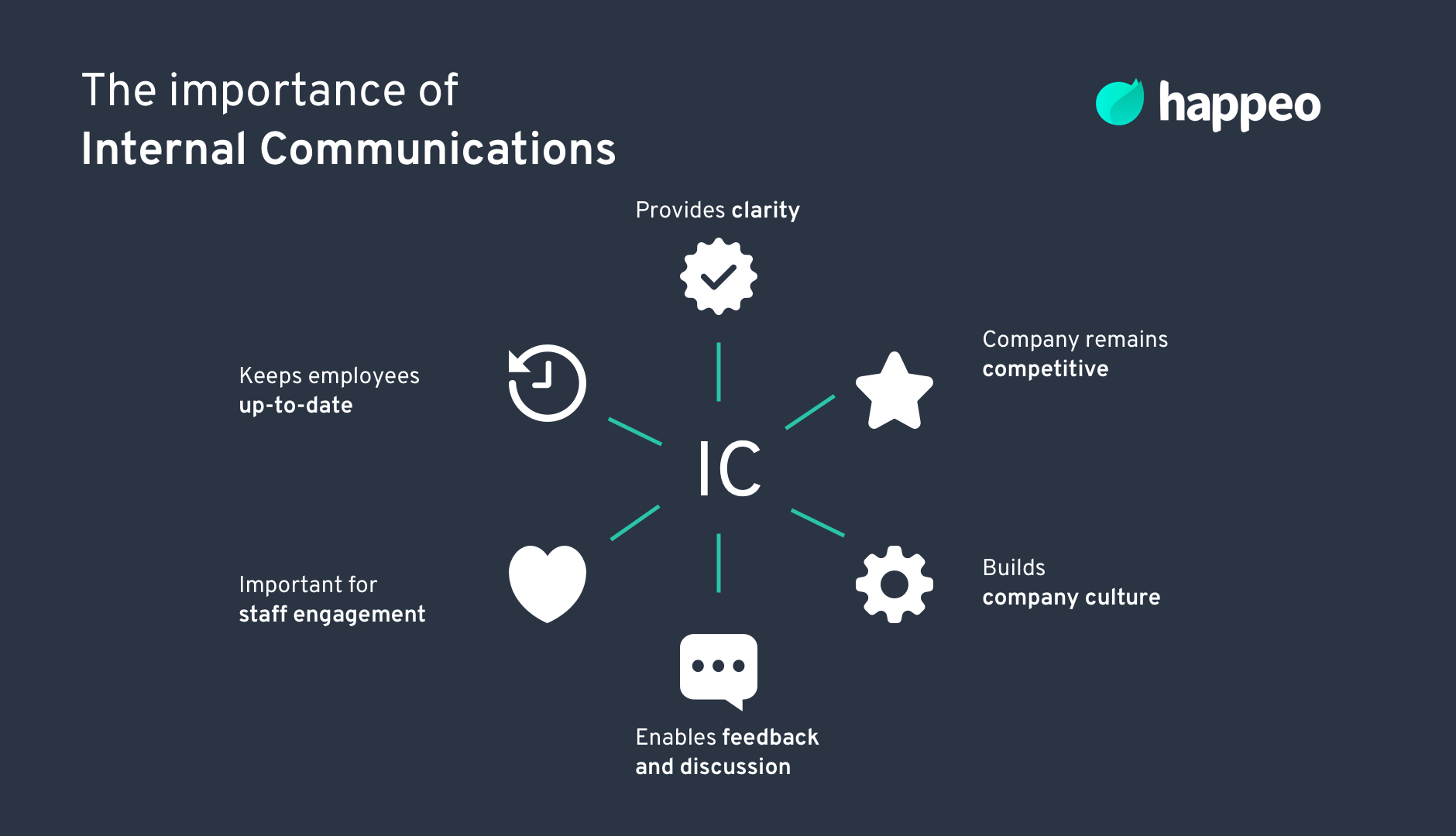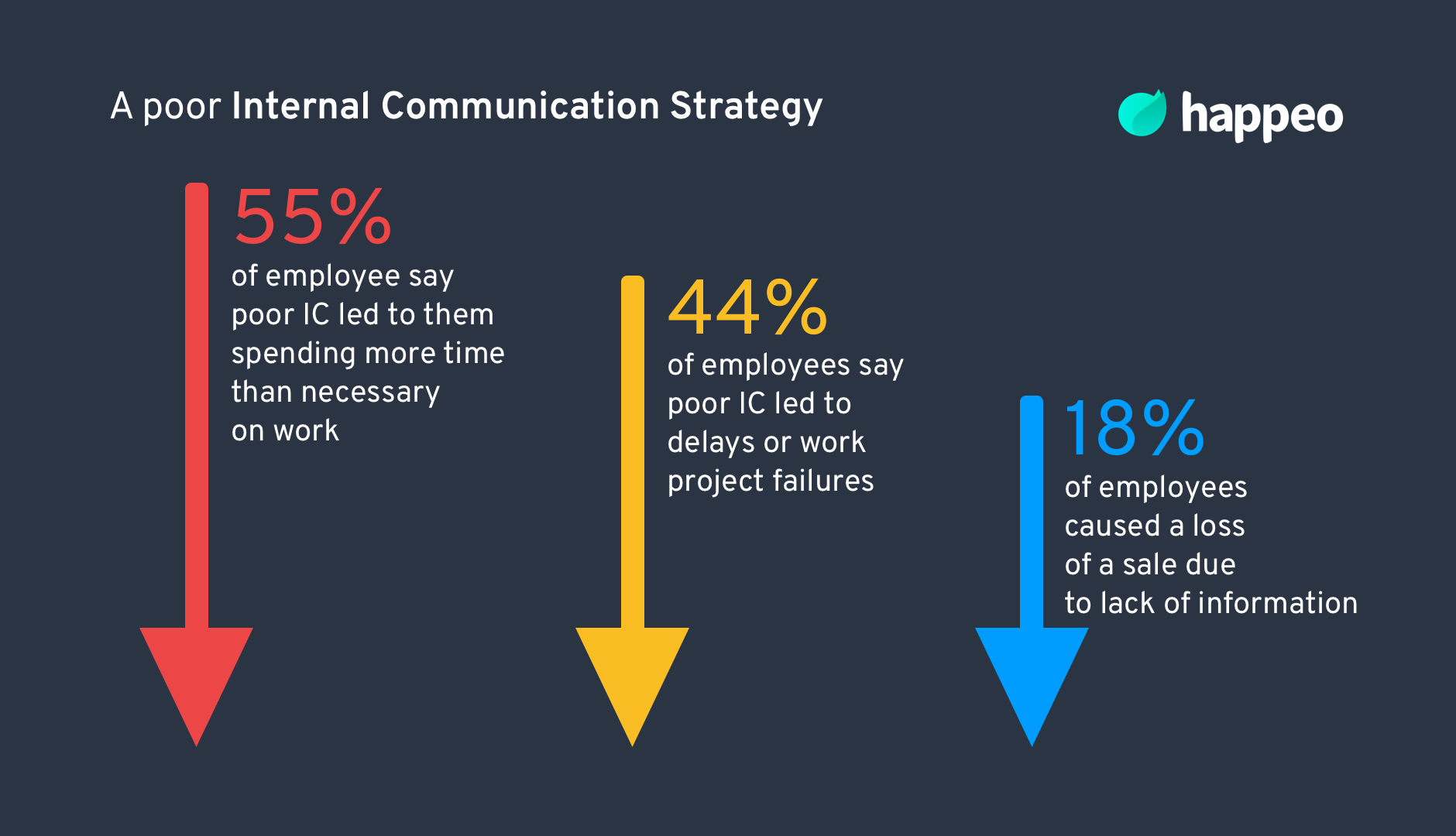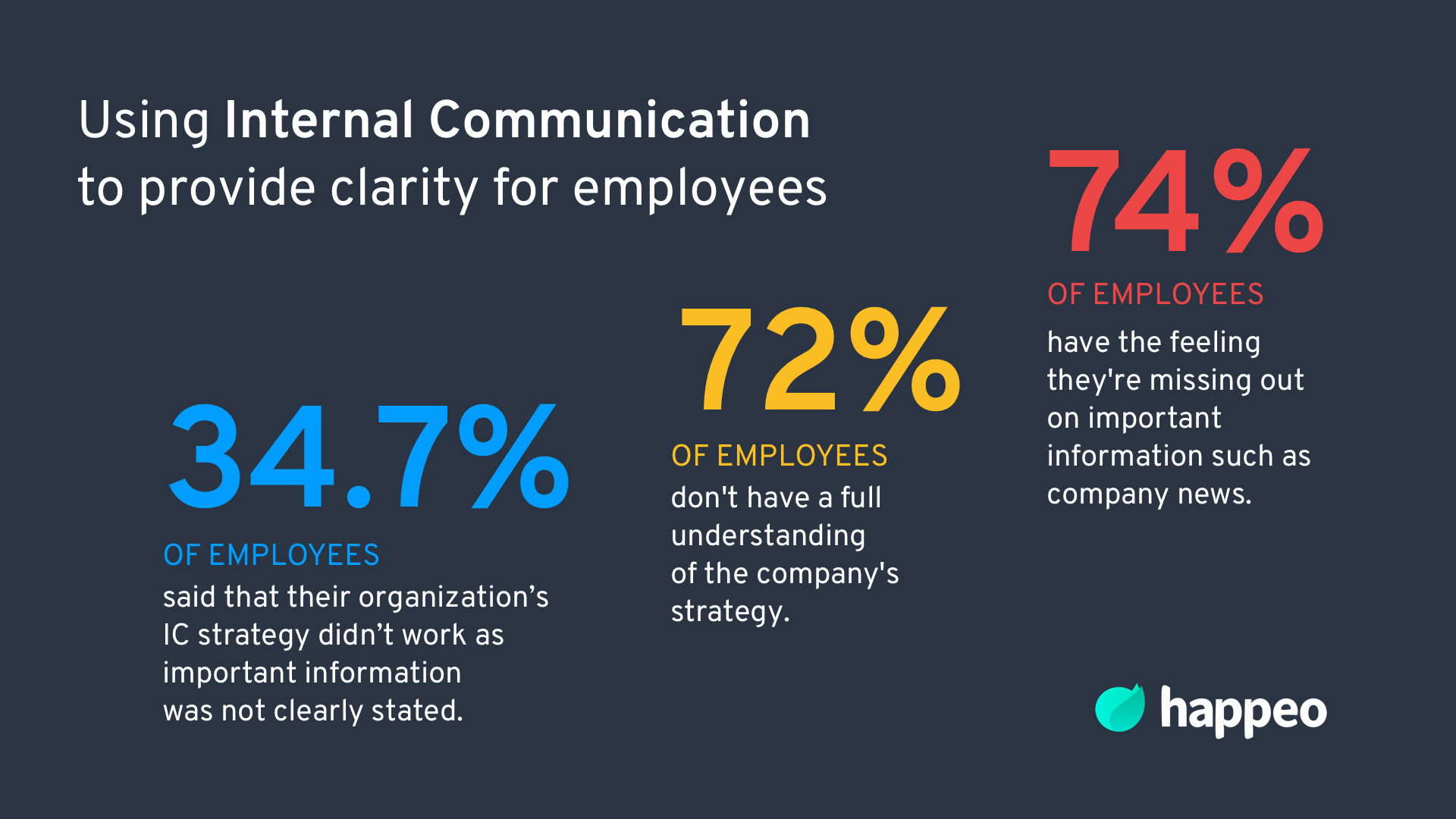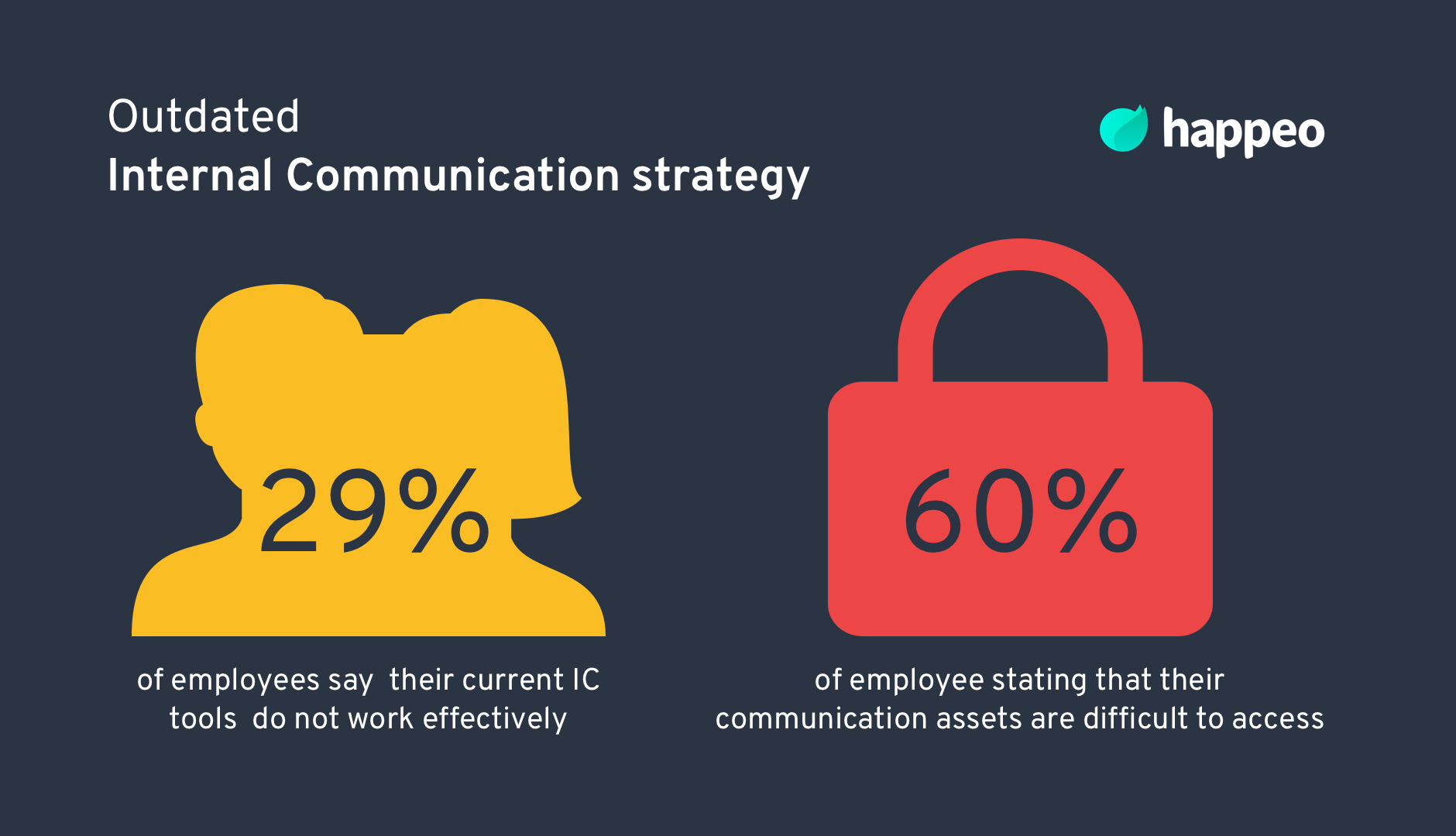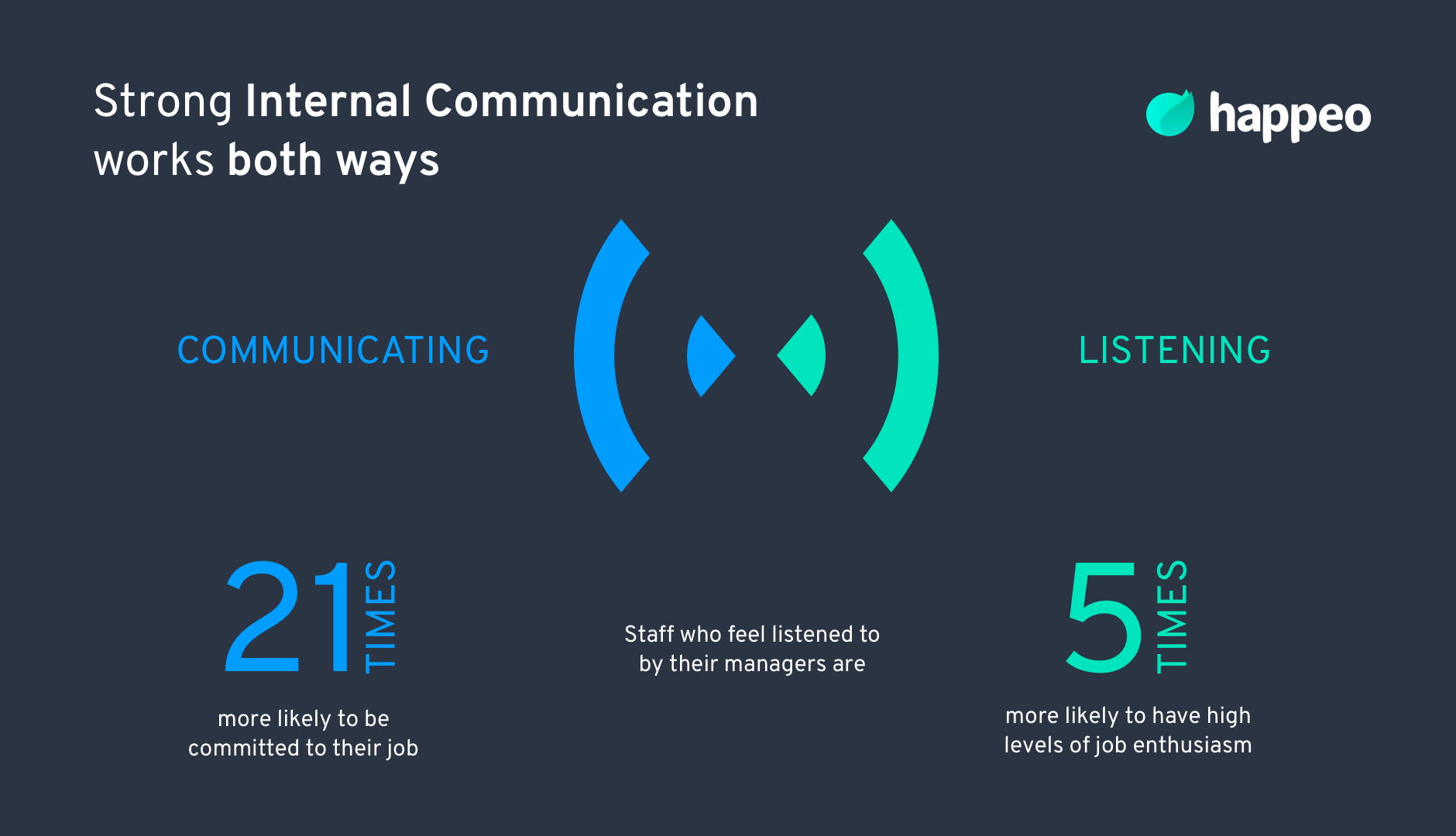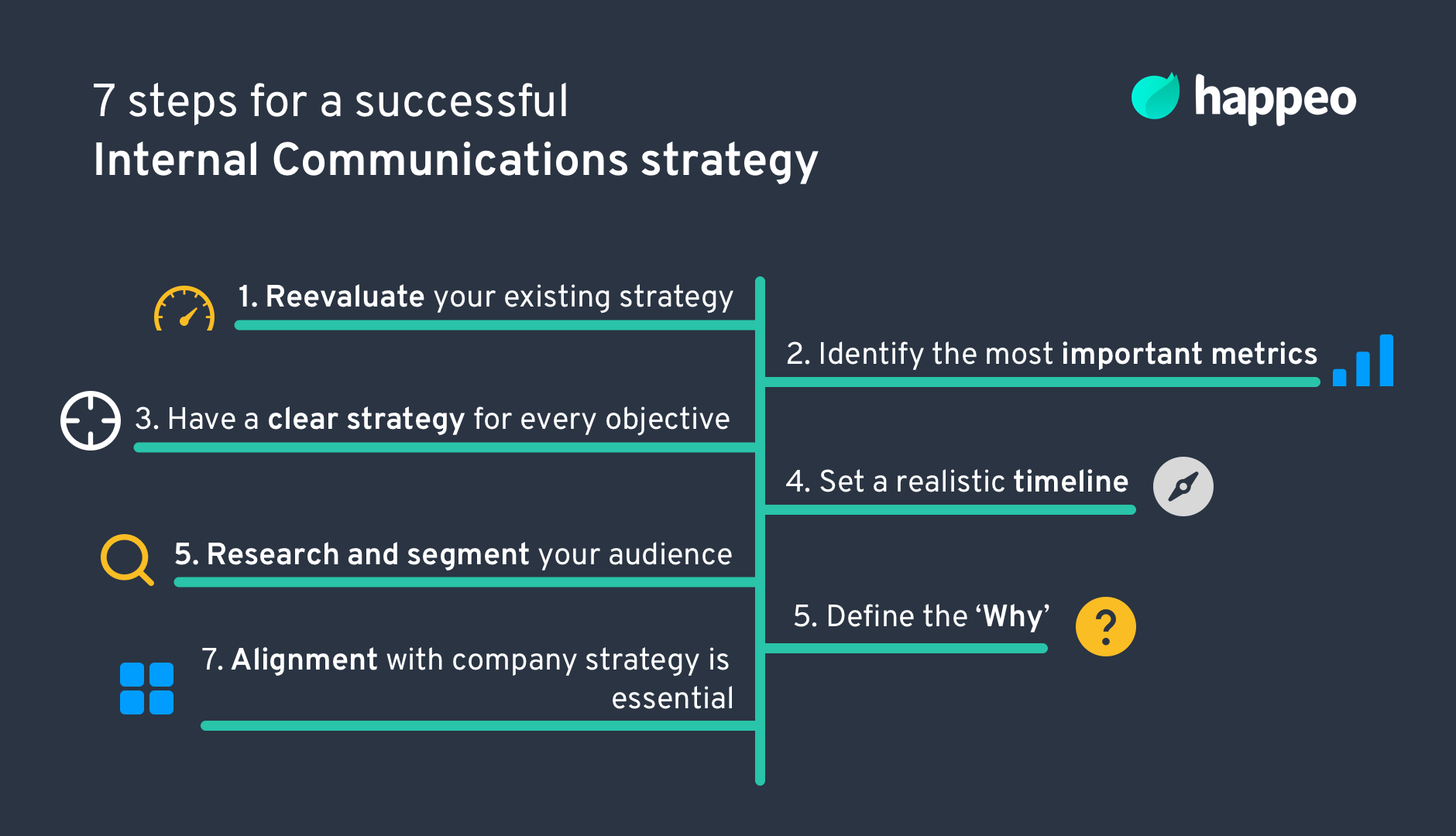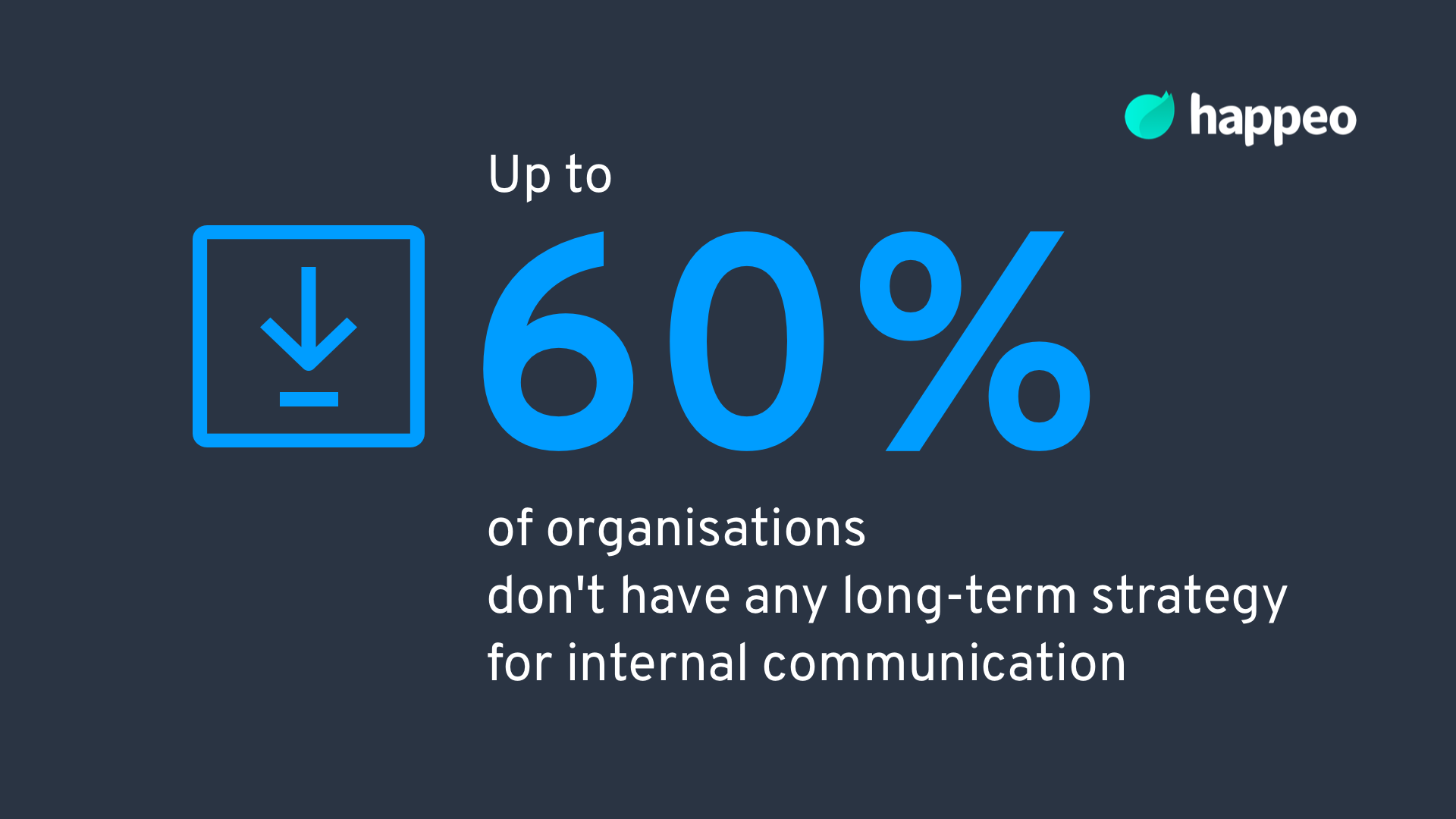Internal Communications Guide
Strategies for Success
How effective Internal Communications will benefit your organization by keeping your team connected, engaged and motivated.

See how an intranet works
Learn how an intranet works with this short video.
Introduction
Internal Communications is the business engine that drives productivity, collaboration, workforce engagement and even employee advocacy - that is, if it’s done correctly. Conversely, a poor Internal Communications strategy in place (or not having one at all) can harm your business. Research shows that up to 60% of organizations don't have any long-term strategy for internal communication in place. Further, 91% of employees say that their leaders lack communication skills and 72% of employees don't have a full understanding of the company's strategy. From ineffective and unproductive day-to-day operations to a lack of cross-departmental communications and disenchanted, disconnected staff with high levels of turnover, the impact can be wide-reaching. Continue reading and learn about the importance of Internal Communications and how to improve and measure it in your organization.

Unfortunately, for many companies, the chasm between Internal Communications best practices and reality can be extensive. However, we understand that making changes to your existing Internal Communications strategy, or creating an Internal Communications strategy from scratch can be a daunting prospect, and especially so without guidance.
But our step-by-step guide is going to help you execute a successful Internal Communications strategy and action plan for your company. We’ll also be addressing internal barriers of communication and provide tips on overcoming then.
Below are the points we’ll be covering in this guide. To skip ahead to a section, simply click on the section heading most relevant to you.
Keep reading to find out:
What is Internal Communications?
Internal Communications (IC) within businesses refers to the way a company interacts with employees bringing clarity to an organization’s objectives with everyone working towards a common goal. It is also about building a company culture that fosters its external business values internally too. The overarching aim of IC, is to leverage effective company communication to all staff members.
But what exactly does this entail and what is an Internal Communications team responsible for?
- Crafting a clear Internal Communications strategy with management
- Creating and delivering company messages on behalf of management
- Facilitating a company dialogue on new updates or developments: such as an event, new software being used or a new policy
- Plans and writes all content for Internal Communication purposes - including on the intranet, newsletter and magazines
- Fostering a company culture
- Communicating with employees internally via social media
- Responsible for handling central communication response to crisis situations
- Creating and developing campaigns to get staff involved
- Asking for company feedback from staff and implementing solutions
- Implementing changes related to digital communications
- Factoring in cultural differences in Internal Communications
- Event management: bringing employees together to collaborate
In summary, the main responsibilities of an Internal Communications team can be seen to comprise of three areas:
- Alignment: creates lines of communication between employees and management
- Voice: gives employees a voice and listens to feedback
- Involve: encourages employees active participation in events or trainings
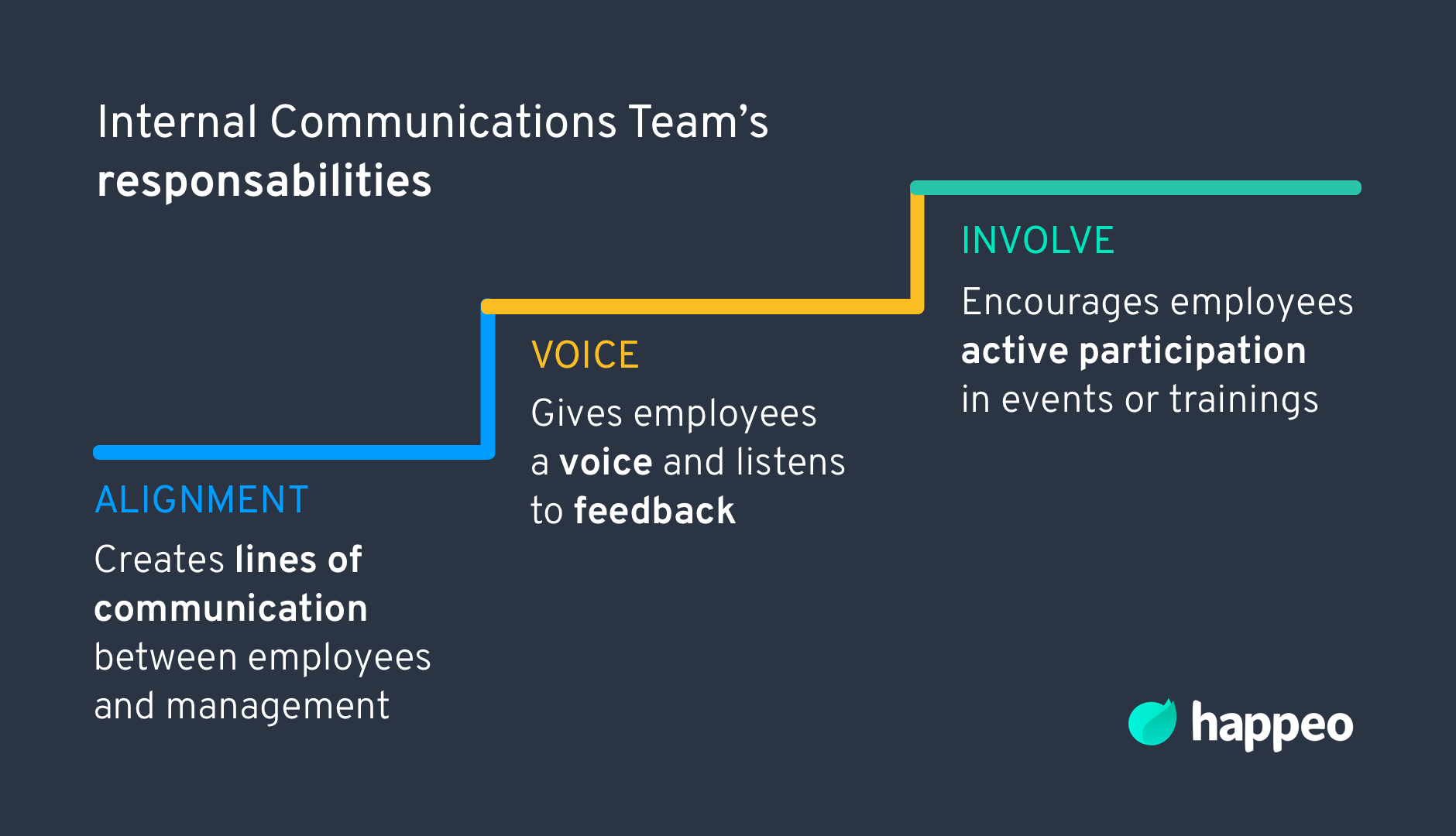
Read more about the most important Internal Communications skills in one of our popular blog posts.
The history of Internal Communications
The staff magazine is where the concept of Internal Communications truly begins. In fact, the UK’s Institute for Internal Communications was originally called the British Association of Industrial Editors, emphasising the early importance of internal newsletters. There’s even evidence of internal newspapers developed and written by employees dating back to the 1840s.
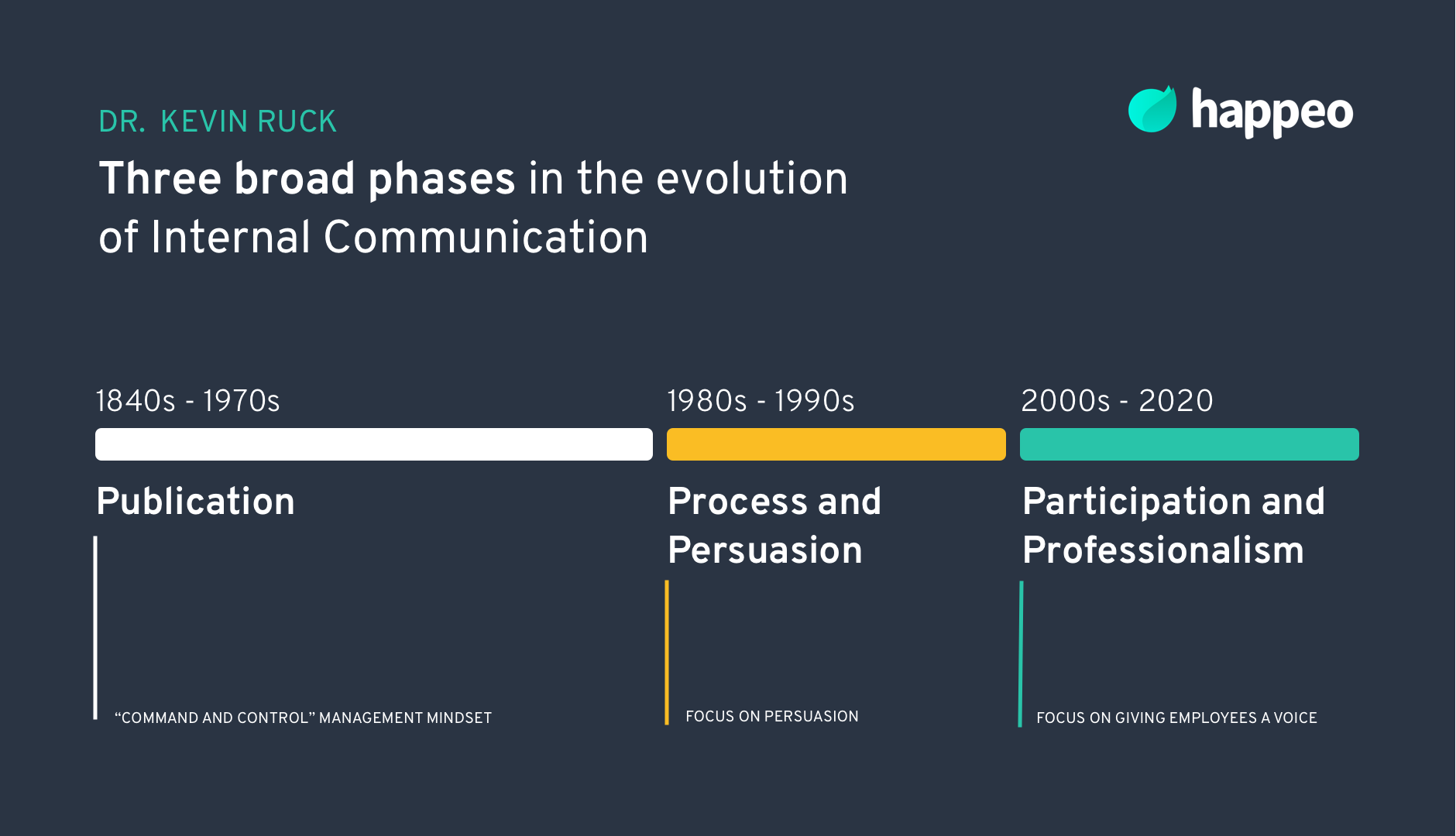
Dr Kevin Ruck writes of three broad phases in the evolution of internal communication:
Publication: the practice is dominated by industrial editors between the 1840s and 1970s who published newspapers and magazines to tell management-led stories. Dr. Ruck says this reflects a “command and control” management mindset.
Process and Persuasion: the scope of practice widens in the 1980s and 1990s as more channels become available and planning and measurement gain importance. There’s also more focus from Internal Comms specialists on persuasion, which makes sense as these were times of industrial unrest and change – especially with the beginnings of the digital workplace.
Participation and Professionalism: the 21st century practice of Internal Communications continues to widen as technology transforms the way we communicate. There is more focus on giving employees a voice, and Internal Comms specialists can access specialist qualifications. The importance of Internal Communications strategy becomes a focus.
The first textbook on Internal Communications was released in 1942 - Alexander Heron’s Sharing Information With Employees - which took into account societal and cultural influences on employees and companies and defined a new way of doing business. But business didn’t really listen, and much of the 1940s, 50s, 60s and 70s centred on top-down and instructive comms. Things changed in the 1980s as the ad world infiltrated new parts of the business.
The employee started to get more of a focus in the 1990s as employee engagement emerged as an Internal Communications best practice, with a push for the workforce to express itself physically, cognitively and emotionally at work. The ideal was that employees’ self-worth would be tied up in what they did and who they did it for. Yet, layers and layers of middle management diluted the messages.
The new millennium brought with it new technology and new ways to reach the masses, and this infiltrated Internal Comms practice, too. No longer just a team to pass out information, Internal Communications began to shape the way to do business and the Internal Comms strategy became paramount. The concept of the employee value proposition (EVP) emerged, too, and IC worked hand-in-hand with HR to deliver value and attract the best talent.
Today, it’s more about “internal conversation” than communications in internal communication best practices: great businesses recognise the need to take the employee voice seriously.
Why is Internal Communications important?
Strong Internal Communications is the foundation of any healthy business, which is why it’s so fundamentally important to incorporate into your overarching business strategy. Here's why Internal Communications is important:
- Keeps employees up-to-date
- Important for staff engagement
- Builds company culture
- Provides clarity
- Enables feedback and discussion
- Company remains competitive
Research from Papirfly shows some important findings about the importance of internal communication. Up to 60% of organizations don't have any long-term strategy for internal communication. 21% of internal communication professionals do not use any level of professional planning for internal communication. Only 54% of internal communicators say that their process of communications objectives are researched, measured and evaluated.
Internal Communications keeps employees up-to-date
Employees want to be kept up-to-date with the company’s latest news – a Bambu report shows an overwhelming majority (79.8% surveyed) said they wanted to be kept in the loop, and Internal Communications is an excellent way of achieving this.
It also instils transparency within the business - which will strengthen your team too. For example, in the same survey, the majority of employees stated that knowing the latest company news would enable them to do a better job (66%) and even have better relations with other staff (66%).
Internal Communications is important for staff engagement
- 70.1% of employees say they are not very engaged with their work - and a lack of engagement affects motivation and productivity levels, and may ultimately become a vicious cycle. Unfortunately, one of the main reasons could be due to a poor internal communications strategy.
- 44% of employees say poor internal communication led to delays or work project failures
- 18% of employees caused a loss of a sale due to lack of information
- 55% of employee say poor internal communication led to them spending more time than necessary on work
But by implementing strong internal communication best practices, you facilitate employee engagement – and engaged employees are those who will be driving your business forward.
That’s because higher levels of employee engagement have a positive domino effect on business performance.
Internal Communications builds company culture
Implementing an excellent Internal Communications plan is a surefire way to kickstart a thriving company culture. Why? Every announcement, blog article or message communicated to staff influences how employees will interpret your company's values and company beliefs.
But why does company culture matter so much? Statistics show that a positive workplace culture has a considerable impact on their enjoyment and levels of engagement with work, increasing staff retention. A Gallup survey shows that engaged employees are 59% less likely to search for another job with a different company within a 12 month period.
Internal Communications provides clarity
A strong internal communication strategy provides clear expectations to staff about what they are supposed to do and makes them aware of important company information with ease.
- 34.7% of employees said that their organization's IC strategy didn't work as important information was not clearly stated
- IMB says that 72% of employees don't have a full understanding of the company's strategy
- Gallup found out that 74% of employees have the feeling they’re missing out on important information such as company news
A clear IC strategy can also help prevent a possible disconnect occurring between employees and customers/clients, and improve customer service.
Internal Communications enables feedback and discussion
One of the main reasons why Internal Communications is so important is that if done effectively, it can facilitate feedback, discussion and debate. This can be a great way of helping the company improve and avoid making the same errors in the future.
Internal Communications help companies to remain competitive
Consistently modifying your Internal Communications is vital in order to stay competitive, to retain the best talent. This has become even more pertinent now that lifelong job security is a thing of the past, meaning businesses need to work even harder to keep on-board.
Challenges in Internal Communications
Great internal communication can help create a more productive and motivated workforce, but it's not without its difficulties. But what are the main internal communications challenges companies are facing today?
- Outdated strategy
- Generational divide
- Lack of information
- Not tracking metrics
- Failing to include remote workers
- Budget limitations
- One-way communication
- No interdepartmental communication
- Reputation of Internal Communications
- Cultural barriers
Challenge 1: Outdated strategy
Email still remains the number one channel for Internal Communications for many businesses, despite the huge variety of communication apps and internal communication tools that can be used for far more efficient workflows. 29% of employees say their current internal communication tools do not work effectively, with 60% stating that employee communication assets are difficult to access, both can lead to a number of roadblocks.
For example, a study by the Danwood Group shows that it takes approximately 64 seconds to recover from an email interruption. When you consider that we usually receive 78 emails per day, - and (only 38% on average are important ) this means a considerable amount of daily distraction.
Challenge 2: Generational divide
Not considering the different ways of communicating among generations could be an impediment to effective Internal Communications. For example Millennials and Gen Z Lean towards instant messaging and texts as their main methods of communication easier having grown up in the digital revolution. Meanwhile, baby boomers typically prefer traditional ways of communicating such as phone calls, emails and in-person conversations. These preferences need to be considered in a now multi-generational workforce.
Challenge 3: Lack of information
A McKinsey study shows that only 3% of staff say they have enough information about their organization, department or industry. 72% of employees also say they do not have a full understanding of their company’s internal communication strategy.This is a big problem for effective Internal Communications.
A lack of information causes confusion and frustration for employees, which will have a knock-on effect on the work they produce.
What do employees typically worry about when there is a lack of information from Internal Communications? In fact a lack of internal communication can cause employees to worry or gossip for up to 2 hours a day. The biggest worry of employees is to receive a pay cut (33% of employees), followed by losing their job (30% of employees).
The consequences can be wide-ranging. A workplace survey showed that as a result of poor internal communication:
- 52% of employees said they experienced higher levels of workplace stress
- 44% of employees did not complete their work projects
- 31% of employees failed to meet performance goals
- 20% of employees found there was innovation obstacles
If a lack of information continues over a long period of time, it can lead employees to leave the firm altogether – at a costly price. It typically costs a company 150% of their annual salaries in order to replace them.
Challenge 4: Not tracking metrics
Failing to track internal communication metrics is a major roadblock for a company’s ability to measure success. A recent study showed that approximately 19% of internal communicators do not track their metrics.
And even among those who do, there's an uncertainty about the metrics being used. Just 22% said in a report that they were confident they were tracking the right metrics to improve their Internal Communications, which suggests huge room for improvement.
Challenge 5: Failing to Include remote workers
66% of businesses now allow remote working opportunities, yet failing to incorporate remote workers into Internal Communications, or not knowing how to, is a big problem for many businesses and could have a negative impact on engagement levels.
When it comes to the relationship between remote workers and internal communication strategies:
- 63% of remote workers said they have all of the information needed to do their job
- 36% of remote workers said their line manager is an accurate source of information
- 27% of remote workers said they did not have enough information about their company
Challenge 6: Budget limitations
Budget limitations can often pose difficulties for internal communication teams, impacting their ability to implement new communication tools or software on a wider scale. This is usually as a result of failing to align an internal communication strategy to their organization’s wider company goals.
Challenge 7: One-way communication
Strong internal communication works both ways: listening is just as important as communicating information to employees. Statistics show that staff who feel listened to by their managers are:
- 21 times more likely to be committed to their job
- 5 times more likely to have high levels of job enthusiasm
Challenge 8: No interdepartmental communication
In order for a company to thrive, internal communication needs to be interdepartmental. Yet more than half of businesses say they have siloed their workforces, and 40% said that their departments had their own agendas.
Challenge 9: Reputation of Internal Communications
The reputation of the IC industry as being non-strategic is at times damaging. This reputation can mean the Internal Communications specialist has to go through middlemen to influence the business. Without a direct line to the C-suite, the job is made much harder.
Challenge 10: Cultural barriers
Cultural barriers can be an issue for Internal Communications specialists, even if you’re not working across borders — the world we live in is a global one, and it’s likely a single office is home to multiple cultures.
Failing to localise communications and consider cultural nuances when necessary can have a harmful effect - it can be the difference between an employee taking the right course of action, or not.
How to improve Internal Communications?
We’ve discussed the importance of internal communication, and potential barriers to it, but how can you overcome these challenges? Let’s take a look at some of the Internal Communications best practices for a productive, engaged workforce, and the methods you can use for effective Internal Communications.
- Update your communication methods
- Feedback and regular evaluations are key
- Engage with a multi-generational workforce
- Build on company transparency
- Focus on cross-cultural communications
- Celebrate successes
Tip 1: Update your communication methods
Prioritise updating communication methods that make collaboration, document and file-sharing easier, without the need for back-and-forth emails.
But keep in mind that depending on the message you want to get across, some communication tools or channels may be better suited than others. For example:
- Job openings could be better advertised on social media
- Chat tools are best for instant messaging or to quickly share internal documents
- Cloud software is best for file sharing
A multi-channel approach with an integrated system is the best Internal Communications strategy to use.
Updating your use of social tools has been highlighted as a great way of fostering connection in teams. A McKinsey study on the use of social tools and communication platforms shows that 80% of employees who have social tools at work communicate regularly with others on their team. Comparatively, only 65% of staff without social tools do so.
Tip 2: Feedback and regular evaluations are key
Feedback and regular evaluations of your Internal Communications from employees should be incorporated into your workflow for optimal IC performance, and to improve overall employee satisfaction. This could take the form of one-to-one meetings, group discussions or anonymous online surveys. Feedback questions could include:
- Which areas can we improve our Internal Communications?
- What are the challenges to daily Internal Communications for you?
- Do you think our Internal Communications are transparent enough?
- Do we communicate well internally?
- Which internal communication tools do you like/dislike using most?
Tip 3: Engage with a multi-generational workforce
Communication preferences vary between generations, and when the workforce landscape is so dynamic, there is simply no other way around it other than considering how you can best engage all generations in an efficient manner, and incorporate this into your internal communication strategy. This might mean using a range of internal communication tools, for example.
Tip 4: Build on company transparency
65% of employees say that Internal Communications aren't comprehensive enough. Make sure you break down information silos within your business’ Internal Communications.
A lack of transparency will impact employee morale and their level of engagement with your company.
Tip 5: Focus on cross-cultural communications
Within an international workforce, taking into account cultural idiosyncrasies in Internal Communications is vital, to ensure that the intended message is delivered.
Try to incorporate localisation and transcreation — so that the overarching message is translated into the local context. Where multinationals can handle the resource, it’s worth considering regional Internal Communications specialists to help with this, or bring in local champions to help get the global message across on dedicated internal communication channels.
Read more: These 7 Internal Communications specialists influence the non-English speaking world.
Tip 6: Celebrate successes
If you want to build a strong company culture, then your Internal Communications should also pay special attention to celebrating employees' successes. If staff feel valued for their contributions, this will go a long way in terms of motivating them to work even harder for your business.
7 steps for a successful Internal Communications strategy
If you're looking to revamp an existing Internal Communications strategy, the thought itself might be a little off-putting - where do you start?
Take a look at our list of internal communication ideas. Simply follow our 7-step strategy below to put in place a successful Internal Communications plan that will yield results:
- Reevaluate your existing strategy
- Identify the most important metrics
- Have a clear strategy for every objective
- Set a realistic timeline
- Research and segment your audience
- Define the ‘Why’
- Alignment with company strategy is essential
Step 1: Reevaluate your existing strategy
Before developing a new Internal Communications plan, you should start with looking at your current one to determine what your new strategy should incorporate. Questions to consider include:
- What is the status of your current IC strategy?
- What are the best and worst aspects of your IC strategy?
- Who could be added to the IC strategy to improve it?
- Where do you want to be with your IC strategy?
- How will you reach your IC objectives?
- What resources will you need?
- What is your timeline for reaching the objectives of your strategy?
- Should you add or remove members of your IC team?
Step 2: Identify the most important metrics
For an Internal Communications strategy to be successful, you’ll need to know your most important metrics. By doing so, you’ll be able to analyze which areas of IC in your organization require attention, or that can be defined as internal communication goals.
Metrics we advise looking at include:
- Employee referrals: how many do you currently receive, and how can you improve
- Project management: are there areas where there are constant issues?
- Staff engagement: do employees frequently read, leave comments or start discussion
with internal content? Do employees feel heard and share company values? - Social media: how frequently do employees share your content, increasing brand awareness?
Step 3: Have a clear strategy for every objective
Whether you have one overarching Internal Communications objective or a number of them, make sure that you have established a clear strategy and mapped out how these can be achieved. This might include stating the internal communication tools you will use to successfully complete the intended objective.
Step 4: Set a realistic timeline
60% of companies do not have a long-term Internal Communications strategy, but thinking ahead, and planning a realistic timescale is an important aspect of an effective Internal Communications strategy. When doing so, make sure you have clearly defined roles and responsibilities beforehand, including what needs to be done, who is doing it, as well as who needs to sign off on it.
Step 5: Research and segment your audience
Audiences, too, are key to strategy. “Employees” is not a targeted audience; think instead about job roles, locations, or where they are in the employee lifecycle. Segmentation is needed before you start communicating, and stakeholder mapping can be an important exercise for your strategy, too.
Step 6: Define the ‘Why’
When putting together an Internal Communications strategy, it's important to identify what exactly you want employees to engage with, and also define why they should. Try to think about the following questions:
- What do you want your audience to know for them to implement change or action?
- What is the end result - what do you want employees to do?
- What do they need to feel in order to implement the desired change or action?
- Employees need meaning and a clear vision in order to fully engage with the job and to understand why their input is valuable to the company achieving its goals.
Step 7: Alignment with company strategy is essential
A key aspect of any effective Internal Communications strategy is ensuring that it aligns with the company’s overarching business values and goals. Any Internal Communications strategy you develop must be aligned to the C-Suite’s business objectives for it to be taken seriously as a growth enabler.
Make sure you speak the language of leadership and understand what matters to them. Link back to their goals — they don’t care about intranet reads unless it led to increased productivity and profit.
Using the right Internal Communications software
Whether it be intranet software, messaging platforms, video conferencing tools or project management tools: using the right internal communication tools has the ability to facilitate a strong communication strategy within a company, improving employee engagement and overall efficiency. But there isn’t a one-size-fits-all formula when it comes to using them - some tools may suit your company's needs better than others.
Nevertheless, with so many options available, how do you know what are the best internal communication tools to use? Take a look at our shortlist below:
- Chat tools
- Video conferencing tools
- Team collaboration and management tools
- Intranet software
- Traditional intranet (Intranet 1.0)
- Social intranet (Intranet 2.0)
- Enterprise Social Networks (ESNs)
Software #1: Chat tools
Internal communication is all about facilitating open collaboration and idea-sharing and chat tools like Slack, HipChat, Chanty enable employees to do so, either in a private or group chat. Chat tools also enable live chat features, video chat and seamless integration with popular tools.
Best chat tools
- Slack
- HipChat
- Chanty
Advantages of chat tools
- Increased collaboration
- Facilitates knowledge sharing
- Real-time chat
- Ease of use
- Integration with popular tools
- Written conversation record
Disadvantages of chat tools
- Can lead to siloed communication between teams
- Unable to access company document database
- Too many chat threads can be distracting
- Low employee participation rate
- Software #2: Video conferencing tools
Video conferencing tools like Google Meet, Zoom and BlueJeans have become a necessity for many companies worldwide, thanks to the unprecedented rise in remote working. When used correctly, video conferencing software can have a positive impact on productivity and engagement, as well as enabling remote staff to feel more connected.
Best video conferencing tools
- Google Meet
- Zoom
- BlueJeans
Advantages of video conferencing tools
- Increases productivity
- Better productivity
- Improves engagement
- High attendance
Disadvantages of video conferencing tools
- Unreliable due to slow internet connections
- If used too frequently, can decrease engagement
- Can feel impersonal within a large conference or webinar
Software #3: Team collaboration and management tools
Popular team collaboration and management tools such as Trello, Asana and Google Docs allow teams to collaborate with ease, by enabling multiple users to plan and manage projects and tasks seamlessly. This is down to the ability to easily file share, provide access to important documents, add notes and track changes too. Such tools make efficient workflows far easier to implement.
Best team collaboration and management tools
- Google Docs
- Asana
- Trello
- G Suite
Advantages of team collaboration and management tools
- Aids efficient workflows
- Better organization of projects
- Enables collaboration
- Multiple users can work on the same document at once
- Projects stored in one place
- Easy to use
Disadvantages of team collaboration and management tools
- Limited integration capabilities
- Difficulties with adding comments in project management tools
- Security risks need to be considered
Software #4: Intranet software
Intranets function as all-in-one digital workspaces that facilitate better collaboration between teams, but what are the different types of intranet software for internal communication?
Traditional Intranet (Intranet 1.0)
A traditional Intranet incorporates the features you’d expect from standard intranet software, featuring top-down communications of the latest news and updates, as well as access to important company documents.
Advantages of a traditional intranet
- Access to important company documents
- Can view the latest news and updates
Disadvantages of a traditional intranet
- Lacks opportunity to grow employee knowledge base
- Static information sharing
- Employees are not actively engaged
Social Intranet (Intranet 2.0)
A social intranet is more than just a desktop publishing platform — as an Internal Communications channel, it enables discussion and two-way communications, collaboration on projects, and streamlined productivity. Where a social intranet really comes into its own is not just as the disseminator of news, but as the go-to source for all internal processes and questions.
Advantages of a social intranet
- Better productivity
- Improved cross-level communication
- Facilitates knowledge sharing
- Helps create a work culture
- Increases collaboration
- Reduces email clutter
- Engaged employees
Disadvantages of social intranet
- Requires change to work culture
- Less face-to-face interaction
Software #5: Enterprise Social Networks (ESNs)
ESNs are business versions of popular social media sites such as Facebook and Twitter, with the most popular ESNs being Workplace by Facebook or Yammer. Each employee has their own ESN profile, and these ESNs can be particularly useful for networking opportunities and instant messaging.
Best ESNs
- Workplace
- Yammer
Advantages of an ESN
- Great instant messaging capabilities
- Good for a strong work culture
- Easy social communication
- Facilitates collaboration
Disadvantages of an ESN
- Lacks access to company documents
- Possibility of distraction
Internal Communications goals
Setting clearly defined, realistic goals is the cornerstone of any internal communication plan.
Why? If you and your Internal Communications team are unclear about what exactly you are aiming for (as well as what their individual role is in producing these results) – then how are you going to reach your goals? Without defining measurable internal communication goals, you risk important information not being clearly communicated from management down to employees – and this could have harmful consequences for the success of your firm.
But how do you define measurable goals in the first place? Follow these 3 steps before defining your goals:
- Plan with your Internal Communications team
- Incorporate employee feedback
- Include smart objectives
Goal 1: Plan with your Internal Communications team
To start with, we recommend discussing with your IC team the following:
- What is the main outcome you want your Internal Communications strategy to achieve for your business?
- Which areas of your strategy are already working well, and which aren’t?
- How can you make improvements to these IC strategy weaknesses?
- When do you want to achieve this goal?
- Do you have the tools, platforms and budgets to implement this strategy?
Goal 2: Incorporate employee feedback
As we have previously mentioned, getting feedback from employees is also a vital component of an effective communications strategy, and one of the most important reasons for this is that it can be an excellent way of determining future goals. That means you need to genuinely consider and incorporate the employee feedback you receive - there is little point conducting employee feedback if you do not take it onboard.
Goal 3: Include smart objectives
Your Internal Communications strategy should include SMART objectives — those that are specific, measurable, achievable, realistic and time-based.
It’s no good to say you want to “help grow employee engagement” — what does “grow” mean specifically? How will you know if it’s grown — how will you measure it? Once you’ve been specific about how much you want to grow it and set a target against that, make sure the target is realistic and achievable — it’s better to aim small and grow from there. And finally, give yourself a deadline otherwise you’ll never know if you’ve achieved your strategic goal.
How to measure Internal Communications?
Measuring the success of your Internal Communications strategy is essential – otherwise, you have no way of knowing if you have reached your desired outcomes. By analysing your core metrics, you’ll be able to determine actionable areas of improvement and from these insights, take the necessary steps forward in order to reach your internal communication goals.
What are the most effective ways of measuring internal communications?
- Google Analytics can help you track what’s working with your Internal Communications strategy, and what content is being read
- Chat tools such as Slack help to encourage dialogue regarding your Internal Communications strategy - this could include adding a channel for questions that senior leadership can answer
- A G Suite intranet can sync with both these tools so that you easily monitor and measure Internal Communications in one place.
But what measurements do you look at when determining the success of your strategy? We recommend that you use the following as a starting point to gauge effectiveness of your IC: - Employee engagement — such as responses to surveys or employee net promoter scores (eNPS).
- Opens and click-through rates for communications — indicating your comms are being read.
- Responses and feedback — the dialogue and conversation that is happening within your channels.
- Staff turnover rate — poor communication can lead to poor culture, and while IC isn’t solely responsible for turnover it can have an impact on helping to slow that stay down.
Conclusion
As we have explained in this guide, Internal Communications is inextricably linked to employee engagement, and an engaged workforce comes into work every day with excitement and purpose. This can also have a direct impact on the bottom line, which makes the strategic importance of Internal Communications even clearer.
Measuring the impact of Internal Communications is key to acting more strategically, but how and what to measure can be a tricky decision. Ultimately, this will be impacted by the tools you have at your disposal, and what your strategic outcomes will be.


